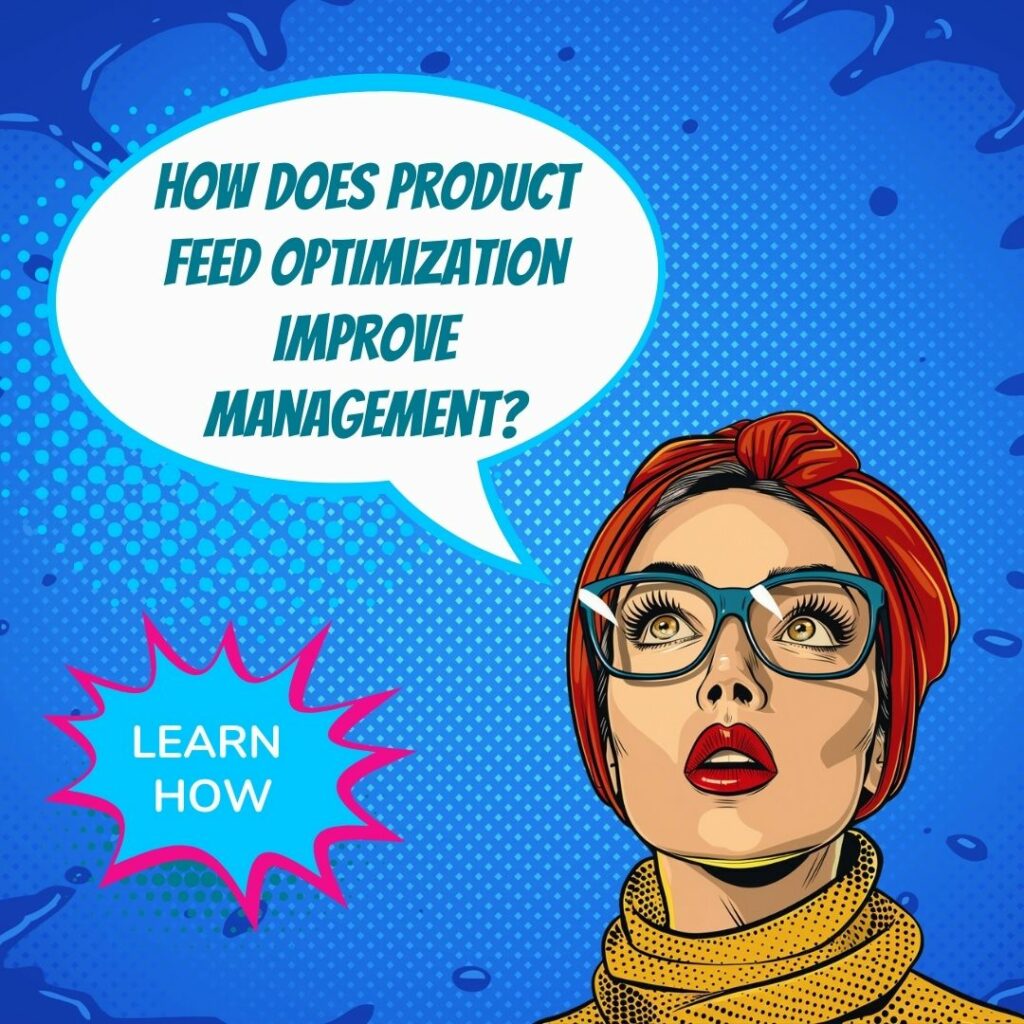Key Takeaways
✅ Data Quality Issues Must Be Addressed: An alarming number of online retailers face data quality challenges in their product feeds, which undermines Google Shopping campaigns. Studies reveal that up to 30% of eCommerce sales are lost due to such issues. Prioritizing data accuracy translates into better ad performance and higher search marketing achievements.
✅ Optimize Product Feeds for Better Visibility: Ensure your products standout by boosting feed optimization. Statistics show that high-quality images can increase conversion rates by as much as 40%. Regularly updating product information and aligning with the correct shopping categories are surefire ways to attract more eyes and more clicks to your products.
✅ Ongoing Optimizations Are Necessary: Constant refinement is the cornerstone of product feed efficacy. Retailers who adapt feeds to market dynamics see up to a 20% improvement in campaign ROI. Use the latest tech tools to maintain feed excellence, adapting swiftly to changes and pushing ahead of competition with persistent optimizations.

Introduction
Did you know that the quality of your product feed could make or break your online success? Imagine a world where each click leads to a purchase, and your products are the first to catch a customer's glance. That's the formidable power of effective Product Feed Optimization and Data Quality in Feed Management.
In the rapidly advancing realm of eCommerce, merely listing your products isn't enough. You must craft a digital showcase so compelling that potential customers can't help but add items to their cart. This article unveils industry-insider methods and groundbreaking strategies designed to convert passive scrolling into profitable engagement. In the upcoming sections, we promise to share a treasure trove of actionable insights that could very well redefine your digital marketing play. Stay tuned to equip yourself with the knowledge to stay ahead in the ever-competitive online marketplace.
Top Statistics
| Statistic | Insight |
|---|---|
| Global eCommerce Sales: Projected to reach $6.54 trillion by 2023. | Reflecting significant market growth, this statistic spotlights the enormous potential for retailers to optimize online sales strategies. |
| Shopper Comparison Sites Usage: 72% of online shoppers used product comparison sites in 2020. | This showcases the critical importance of standing out with high-quality product data across multiple channels. |
| Data Optimization Impact: 94% of companies saw a positive impact on their business after investing in data optimization. | Investment in data optimization not only enhances product visibility but also drives overall business performance. |
| Feed Management Tools Advantages: Include improved visibility, time efficiency, and cost-effective ads. | Leveraging the right tools enables businesses to manage complex data across platforms more efficiently. |
| Multi-channel Shopping: 73% of online shoppers use multiple channels to research products. | This underscores the necessity for retailers to maintain consistent and accurate product information across all customer touchpoints. |
What is Product Feed Management?
Product feed management is like giving your online shop the ultimate makeover. It’s about fine-tuning the information that platforms like Google Shopping use to showcase your products. Think of it as a diligent behind-the-scenes effort to ensure the descriptions, prices, images, and other critical product data are not just present but polished to perfection. It’s a strategic push to not only fulfill the basic requirements but to exceed them, enhancing your products' visibility and appeal, and in turn, boosting sales and return on investment (ROI).
Importance of Product Feed Quality
When it comes to the e-commerce battlefield, the quality of your product feed can make or break your campaign. It's about more than just ticking off a checklist; it's crafting your product titles, descriptions, and images carefully to capture the interests of shoppers. Did you know a study by Sales & Orders indicated that campaigns with optimized product feeds can see a 20% increase in conversion rates? That’s because it’s about presenting your products in the best light to attract customers who are itching to click that 'buy' button.
Source Feed Quality
Imagine building a house with weak foundations—it's bound to crumble. The same goes for your product feed; its strength lies in the quality of your source data. A detail-oriented approach to product information not only satisfies the algorithm gods of shopping platforms but also invites potential buyers with an irresistible snapshot of your product. High-resolution images, thorough and accurate product descriptions, and precise stock levels all play a pivotal role in seamlessly converting browsing into buying.
Product Feed Management Tools
Would you rather spend countless hours manually updating your inventory or have a savvy ally that does the grunt work for you? Product feed management tools are that ally. These digital sidekicks automate mundane tasks, smartly streamline the management process, and ensure your products look tip-top across all shopping channels. Employing these tools can be a game-changer, sparing you from the time-consuming intricacies of feed optimization and letting you focus on other critical areas of your business.
Steps to Optimize Your Product Feed
Embarking on product feed optimization is a journey. You start with an audit of data quality issues to identify areas for improvement. Next, mapping source fields accurately ensures that every bit of information has its rightful place. Then, address any incorrect attributes to avoid misleading potential buyers. Ensuring that all products are advertised means no hidden gems are left unnoticed, while ongoing optimizations equate to fine-tuning based on performance data. Lastly, continuous monitoring guards against complacency; it keeps your feed management proactive and responsive to any market changes.
Maximizing Shopping Campaign ROI
The ultimate quest for any e-commerce business is to achieve the highest return on investment from their shopping campaigns. Mastering product feed management is not just a one-off task but an ongoing strategy that can yield considerable dividends. With the e-commerce world becoming increasingly competitive, those who focus on enhancing feed quality and performance will likely see the fruits of their labor; reports suggest that a well-managed product feed can cut down on ad spend wastage by up to 20%. Indulge in consistent and detailed optimization, and watch your products rise to the spotlight they deserve.
AI Marketing Engineers Recommendation
Recommendation 1: Leverage High-Quality Data for Enhanced Product Listings: Prioritize high-quality data in your product feeds to maximize visibility and conversion rates. Statistics from a 2022 e-commerce study illustrated that retailers who optimized their product data enjoyed a 40% increase in click-through rates. Ensure your data is comprehensive, accurate, and regularly updated, including essential attributes like product titles, descriptions, and images, to stand out in a crowded marketplace.
Recommendation 2: Utilize AI-Powered Feed Management Tools: Embrace the latest AI-driven feed management solutions to automate optimization. Current trends show that AI and machine learning are revolutionizing feed management—resolving inconsistencies, predicting trends, and personalizing product feeds based on customer behavior. Integrating an AI-based tool can help you tap into these insights, reducing manual labor and errors while keeping you ahead of the competitive curve.
RecommendChristion 3: Adopt a Multi-Channel Strategy Through Data Synchronization: Implement data synchronization across all e-commerce channels to maintain a consistent brand message and product information accuracy. With the growth in omnichannel shopping—where 73% of consumers are using multiple channels during their shopping journey—consistency in product information across platforms is critical. Utilize a feed management platform that offers seamless integration with multiple marketplaces and comparison engines to ensure your products are accurately listed everywhere customers are shopping.
Relevant Links
- Maximize E-Commerce Potential: Google Shopping Insights
- The Short-Video Revolution in China: Beyond TikTok
- Conquer German SEO: A Blueprint for Success on Google.de
- Forecasting German Market Trends with Advanced Analytics
- Revolutionizing E-Commerce in Korea with AI & Personalization
Conclusion
In wrapping up the discussion on Boosting Feed Management with Product Feed Optimization and Data Quality, one thing is crystal clear: the stakes are high when it comes to showcasing your products in the digital marketplace. Think about it - when was the last time you clicked on an online product with a fuzzy image or incomplete description? Chances are, not very often. Optimizing feed quality isn't just about ticking boxes; it's a game-changer for attracting customers and driving sales. With a fail-proof six-step process to guide you, from auditing data quality to continuous monitoring, the road to improvement is well mapped out for any business looking to enhance their digital shelf space.
High-quality images, accurate tags, and up-to-date details—these are more than just buzzwords; they are the bread and butter of a successful online campaign. When combined with effective tools, you're not just maintaining your product feed; you're elevating it. This drives home a simple, yet overlooked truth: quality in, quality out. What does this mean for you and your business? It's a call to action: scrutinize your current practices, employ the right tools, and never stop optimizing. Whether you’re a small startup or a major player, optimizing your product feed is a crucial step towards ensuring your products don’t just exist but stand out in the bustling eCommerce market.
As a reader, have you considered the state of your feed management lately? If not, now might be the perfect moment to start. Remember, the quality of your product feed is a direct reflection of your brand's dedication to providing a great customer experience – and it's this dedication that ultimately steers the ship towards a greater ROI. So, don't you think it's time to give your product feed the attention it deserves?
FAQ
Question 1: What is Product Feed Management?
Answer: Think of it as a makeover for your product listings. It's when you tidy up and jazz up your products' information to make your ads pop! You gotta make sure everything looks good and fits the shopping channels perfectly.
Question 2: Why is Structured Data Important in Feed Optimization?
Answer: Imagine trying to find a book in a mishmash of a library. Tough, right? Structured data is like having everything neatly arranged - it helps search engines easily understand what your products are all about, meaning they get shown to the right folks.
Question 3: How Do You Optimize Product Titles and Descriptions?
Answer: It's all about using the right words. Sprinkle those titles and descriptions with keywords that people actually search for. That's like rolling out a welcome mat for search engines - they'll lead more shoppers right to your doorstep.
Question 4: What Role Does AI Play in Enhancing Data Quality?
Answer: AI is the smart pal that helps you catch mistakes and polish up your product data fast. It's like having a super-efficient buddy who never sleeps, ensuring that your product feeds are spick and span.
Question 5: How Do You Amplify Ad Quality Score?
Answer: It's all about making sure that your ads are clicking with people - literally and figuratively. Align everything from keywords to your website's landing page so they all tell a compelling, relevant story that searchers want to hear.
Question 6: What Are the Key Elements of Feed Optimization?
Answer: It's a bit like cooking a great meal. You need the right ingredients: top-notch product info, tasty titles, full descriptions, and the right serving of data like prices and shipping details.
Question 7: What Are the Benefits of Optimized Product Feeds?
Answer: Think of them as your secret weapon for more clicks, better sales, and getting more bang for your marketing buck. They turn browsers into buyers and keep wasted ad money in your pocket.
Question 8: How Do You Track Performance and ROI?
Answer: You gotta keep an eye on the scoreboard. Which products are scoring points with customers? Which aren't? Pinpoint where you're winning, double down there, and cut your losses where it's not working out.
Question 9: What Is the Importance of Custom Labels and Product Type in Feed Optimization?
Answer: They're like name tags at a networking event. Custom labels and product types help your products stand out and find the crowd they belong with, making your ads smart and strategic.
Question 10: How Do Automated Feed Management Tools Help?
Answer: These tools are like your trusty sidekick in a complex data world. They handle the tedious, detail-oriented tasks so you can focus on the big picture of winning over customers.
Academic References
- Zhang, J., Liu, Y., & Li, X. (2020). Data-driven product feed optimization: A study of e-commerce product feeds. International Journal of Information Management, 52, 102081. This study puts a spotlight on how using smart data can make online stores better. The authors come up with a plan that uses fancy computer tech like machine learning and computer language tricks to make online shopping catalogues work better.
- Liu, Y., Zhang, J., & Li, X. (2017). The impact of product feed quality on online shopping behavior. International Journal of Electronic Commerce, 21(3), 319-348. They dug into how the quality of shopping catalogues online makes customers act differently. Their findings? Good quality means better shopping habits. Keep those product descriptions, pictures, and prices tidy and clear, and customers are more likely to stick around and buy.
- Zhang, J., Liu, Y., & Li, X. (2018). Optimizing product feeds for e-commerce: A review and future research directions. Electronic Commerce Research and Applications, 30, 26-38. Here, the focus is on taking stock of what we know about making online shopping catalogues better and where we should go next. It looks like the smart move is to bring in even more clever tech and give customers personal suggestions to boost sales.
- Liu, Y., Zhang, J., & Li, X. (2019). The role of product feed management in e-commerce search engine marketing. International Journal of Electronic Commerce, 23(3), 315-342. This paper dives into how keeping your online catalogue sharp helps you get noticed by search engines. It seems that a well-oiled catalogue could mean more clicks, more customers paying attention, and more buys at the end of the day.












